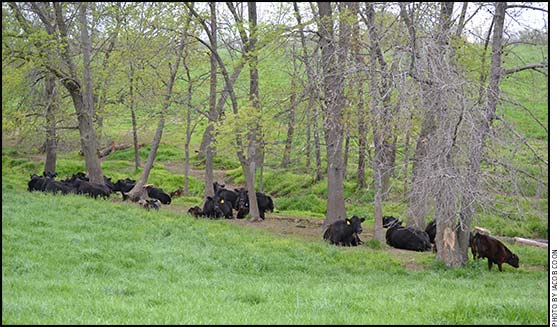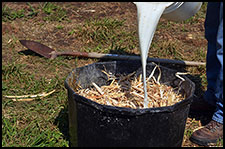HEALTH & NUTRITION...

Prepare Cows for Spring Calving
Three tips to set your herd up for a successful calving season.
Spring calving is just around the corner, providing the promise of a new calf crop and excitement for the future. Steps taken today can set cows up for a successful calving season. However, poor preparation has a direct impact on the health and well-being of those calves, as well as the future reproductive performance of the herd, says Ted Perry, beef nutritionist with Purina Animal Nutrition LLC.
For an optimal calving season, Perry recommends that producers focus on three areas: body condition scores, mineral programs and the area where cows will calve.
“Implementing a few strategies ahead of the calving season can make calving programs successful,” he says, adding that with today’s beef prices producers can’t afford to lose any calves. Read more.
A Warm Bath Can Do the Trick
Research evaluates rewarming methods for cold-stressed newborn calves.
Canadian animal scientists compared methods of reviving hypothermic or cold-stressed baby calves. Heat production and rectal temperature were measured in 19 newborn calves during hypothermia (cold stress) and recovery when four different means of assistance were provided.
Hypothermia of 86° F rectal temperature was induced by immersion in cold water. Calves were rewarmed in a 68° to 77° air environment where thermal assistance was provided by added thermal insulation or by supplemental heat from infrared lamps.
Other calves were rewarmed by immersion in warm water (100°), with or without a 40 cc drench of 20% ethanol in the water. Read more.
Stretching Feed Supplies
Anticipating short feed supplies, beef nutritionist encourages farmers, cattlemen to use technology to make the most of low-quality feedstuffs.
 For the second year in a row, Missouri farmers endured a significant drought, stressing crops, impacting yields and limiting forage supplies for livestock producers.
For the second year in a row, Missouri farmers endured a significant drought, stressing crops, impacting yields and limiting forage supplies for livestock producers.
Justin Sexten, University of Missouri (MU) beef nutritionist, partnered with the Missouri Corn Merchandising Council, the Missouri Cattlemen’s Association and Mississippi Lime to demonstrate how to improve digestibility of corn stover and lower-quality Conservation Reserve Program (CRP) hay by 15% while doubling the feeds’ protein content. He traveled across the state to meet with producers and discuss techniques for improving and extending forage supplies.
“Three of the five years I’ve been here I’ve done drought programming starting in June,” Sexten told a group of producers at the Forage Systems Research Center Field Day in September. “Odds are good that forage supply could be short.” Read more.
Beef Cattle Winter Water Needs
Complicated this Year
Requirements vary, so make sure you are meeting your
cattle’s
water requirements.
Many ponds are low due to the short rainfall during 2012. As cold weather approaches and shallow ponds freeze, there is concern among cattle producers about meeting the water needs of their cattle.
“Some farmers are already hauling water, so it’s a good idea to know how much water different classes of cattle need each day,” said Eldon Cole, a livestock specialist with University of Missouri (MU) Extension.
Water requirements vary depending on the cattle’s size, lactation status, ration they are eating and ambient temperature. Growing heifers, steers and bulls weighing 600 pounds (lb.) require 5.3 gallons (gal.) of water a day when the average ambient temperature is 40° F. Read more.

Rick Rasby
Ridin’ Herd
Contain forage feeding losses.
In drought years, forages are expensive. It is less expensive to have cows graze to meet their nutrient needs compared to hauling harvested forages to them. Not all production systems are designed so that the cow grazes year-round with minimal supplementation. It was a challenge to secure forages this summer for the winter feeding program. Read more.
Pneumonia in Calves
Don’t forget to manage the predisposing factors that set calves up
to be at risk of pneumonia.
Studies have shown that lung damage from calfhood pneumonia can compromise a calf’s potential for later growth. The damage and scar tissue from severe pneumonia may be permanent.
Mike Apley, head of production medicine and clinical pharmacology at Kansas State University’s College of Veterinary Medicine, says the Texas Ranch-to-Rail program showed that calves with lung lesions at slaughter gained less than those that didn’t have lung lesions. Read more.
Using Low-quality Roughages
in Late-gestation Rations
Most spring-calving cow herds are now in late gestation, or will be very soon. This is one of the more critical times on the calendar in terms of optimizing herd productivity. Not only is the bulk of fetal development occurring, but it is also our last realistic chance to put body condition on cows.
Most years, feeding a beef cow herd in the winter is relatively straightforward. We put up hay all summer and feed it all winter. Most years there’s enough good-quality hay to go around. The economics of relying on harvested feed may be an issue, but at least from a standpoint of feed availability and nutritional adequacy, that system has generally worked well.
The drought of 2012 has turned that system on its head. Good-quality grass hay and alfalfa hay is scarce and extremely expensive. Beef producers will be forced to be more creative in their feeding programs, and in many areas that means feed such as salvaged cash-grain crops, low-quality roughages and byproducts. Read more.
Bull-buying Season? Don’t Buy Johne’s
This article leads off the Winter 2013 edition of the Beef Johne’s disease newsletter funded by USDA/APHIS/VS. Due to reorganization and funding cuts by the government, this is the last issue of the newsletter.
If you’re planning to buy one or more bulls this year, Johne’s disease specialists advise you to know the Johne’s disease status of the herd from where you’re buying your bull. That status should be “low risk” as indicated through testing.
“An important means of transmission on beef operations is via infected bulls,” states John Maas, extension veterinarian for the School of Veterinary Medicine at University of California–Davis. “The M. paratuberculosis organism can be found in the semen and accessory sex organs of infected bulls. Read more.
Cattle Diseases: Common Conditions/Terms
Click here for a list of common conditions and terms related to beef cattle diseases, such as anaplasmosis, brucellosis, BVD, E. coli, IBR and others.
[Click here to go to the top of the page.]











